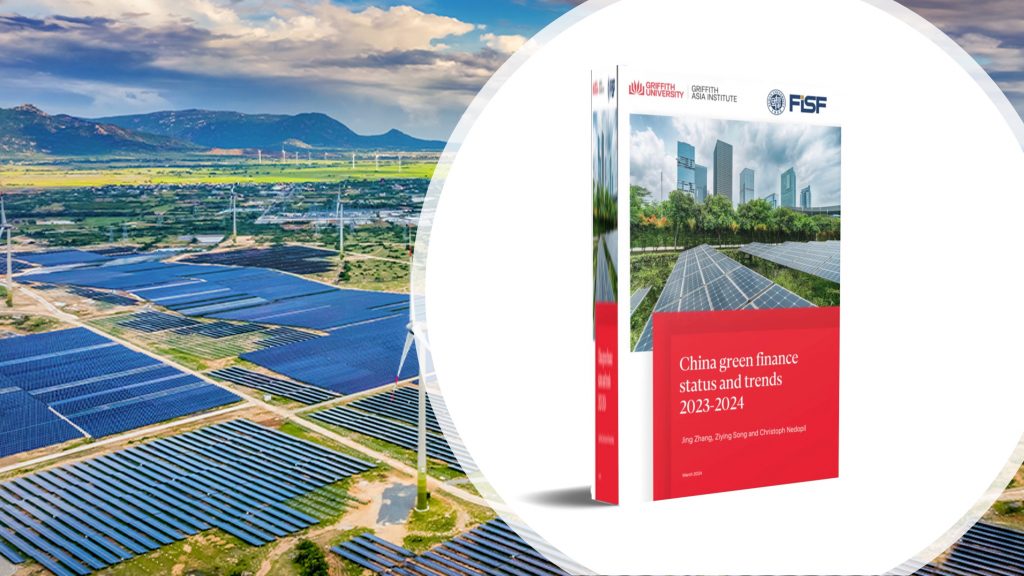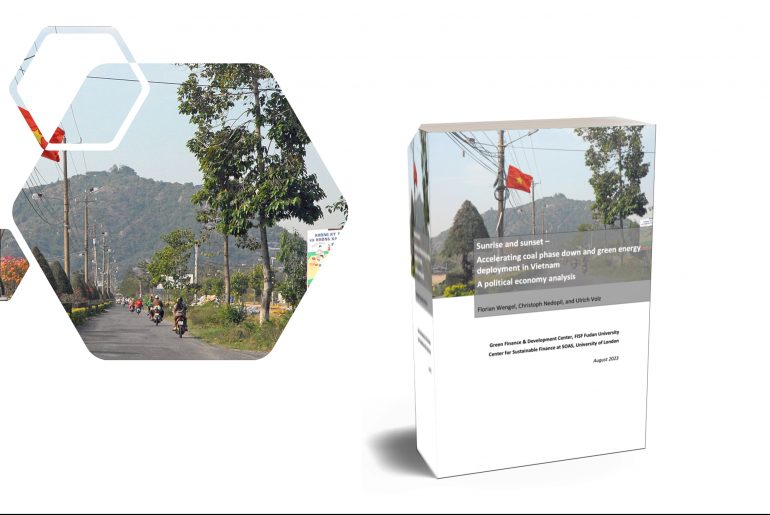In this new report co-published with the Griffith Asia Institute, we look at major developments, trends, and issues in China’s domestic and overseas green finance.
Introduction
Echoing the central government’s “30/60” decarbonisation goal of reaching a carbon peak before 2030 and carbon neutrality before 2060, China attaches great importance to the role of finance in green and low-carbon transition, putting in place a multi-tiered green finance market system, with outstanding green loans and bonds both ranking among the top in the world. Benefiting from “top” government policies and “bottom” local initiatives like the carbon trading market and green finance pilot zones, China has seen rapid development of green industries over the past decade. For instance, China’s BYD overtook Tesla as the world’s best-selling brand of electric vehicles; China’s share of renewable energy capacity—mostly solar, wind and hydro—reached about 50 per cent of its total generation capacity; and the clean energy sector contributed 40 per cent to the 2023 growth of China’s GDP.
In 2023, green finance has been mentioned in several high-level policy documents and by China’s President Xi to support China’s green economic ambitions. Yet progress in policy and green finance application have been mixed.
On the policy side, an important development impacting green finance in China was the establishment of the Central Financial Commission (CFC) for financial decision-making, the creation of the National Financial Regulation Administration (NFRA) to replace the China Banking and Insurance Regulatory Commission (CBIRC), the strengthened role of the CSRC in capital market regulation and the streamline of PBOC on monetary policy and macro-prudential supervision. The governance reshuffle might have led to a slower pace of green finance policy advancement in 2023, for example in transition finance standards or sustainable finance disclosure guidelines. Nevertheless, progress was evident in segments like green insurance and carbon markets through the re-introduction of China Certified Emission Reductions (CCER) after a hiatus since 2017 as well as on sub-national level through new pilots and local regulatory advances (e.g., in Shanghai, Shenzhen).
On the application side, the growth of green financial instruments has been mixed: green loans have grown, while green bond issuances have declined (possibly due to stricter standards on the use of proceeds in force since 2023). This brief, building on the previous report analyses the development of China’s green finance policies and tools in 2023 to identify trends and provide recommended actions to further scale green finance in China. It is a snapshot of various developments and uses specific examples to understand trends and directions. It is by no means a complete guide to Chinese green finance and its developments.
Key findings
Key policies for green finance in China:
- Green finance governance:
- The Central Financial Commission (CFC) was established and takes over the responsibilities from the former FSDC under the State Council, becoming the primary body for financial decision-making and coordination. This move strengthens the China Communist Party (CPC) oversight of financial regulation.
- The National Financial Regulation Administration (NFRA) replaces the CBIRC and takes on broader responsibilities, including oversight of financial holding companies and financial consumer protection (previously under thePBOC’s purview), as well as investor protection (previously under the CSRC’s purview). The reform plan empowers dispatched agencies, particularly the NFRA, to lead the local financial regulatory framework.
- The PBOC now concentrates on monetary policy and macro-prudential supervision, no longer overseeing financial holding companies. The reform plan also streamlines the PBOC’s organisation by replacing nine large regional branches with 31 provincial and five municipal branches.
- The CSRC’s role as the capital market regulator has been enhanced by incorporating supervision of enterprise bond issuance from NDRC into its purview, consolidating oversight of both enterprise and corporate bond issuance. CSRC initiated two sequential reforms in July and December, leading to significant reductions in fee rates and transaction commissions.
- Disclosure standards:
- China’s major stock exchanges in Shanghai and Shenzhen jointly issued draft guidelines for corporate sustainability disclosure in February 2024, mandating ESG information, including Scope 3 emissions and scenario analysis, by April 30, 2026, mirroring the global trend towards ESG transparency.
- The International Sustainability Standards Board (ISSB) opened an office in Beijing after it released the ISSB S1 and S2 sustainability disclosure standards in 2023 with China’s contributions. China’s application of ISSB is uncertain.
- Subnational initiatives: Several local pilot initiatives, including Huzhou, Shanghai, Chongqing, Tianjin, and Hebei, have issued transition finance catalogue. These efforts are poised to serve as a cornerstone for a national-level catalogue.
- Carbon finance: China’s Certificated Emission Reduction (CCER) officially relaunched, with standardised framework and process for voluntary GHG emission trading.
- Green energy: Green Certificates are officially stamped as the sole mechanism for verifying renewable power consumption nationally, assigning oversight to the NEA and ensuring coverage of all renewable sources.
- Green insurance: The green insurance sector established more comprehensive classification standards, statistical systems, and sustainable information disclosure policies through the Insurance Association, which may be adopted by NFRA.
Key developments in green finance instruments:
- The PBOC extended the implementation of carbon-reduction support tool to 2024, and included more foreign banks and local corporate banks. The clean coal re-lending program, set to expire at the end of 2023, has a remaining quota of RMB 25.2 billion (USD 3.57 billion) from its total allocation of RMB 300 billion (USD 42.45 billion). Continuation and additional funding are uncertain, but the remaining allocation is likely to be used up.
- Green loan balance reached RMB 30.08 trillion (USD 4.256 trillion) at Q4 2023, marking a 36.5 per cent year-on-year increase and constituting 12.7 per cent of the total loan balance.
- Green bond issuances decreased by 4.4 per cent in volume in 2023, accounting for 1.17 per cent of the overall bond market. SOEs and financial institutions continue to be the primary participants, although non-SOEs have become increasingly active; offshore green bonds issued by Chinese mainland issuers reached a record low in 2023 due to rate hikes and a lack of property issuers, while foreign investor involvement in green bond issuances in China is resuming but remains limited.
- Green insurance lacks comparable data due to institutional reforms and continuous policy adjustments. However, scattered information suggests that premiums totalled RMB 229.7 billion (USD 32.5 billion) at Q4 2023, and the outstanding investment in the green industry amounted to RMB 1.67 trillion (USD 236.3 billion) at Q2 2023.
- Nearly all green funds, including traditional mutual funds, index funds, ETFs, and WMPs, experienced varying degrees of contraction in 2023 due to investment return challenges, where green funds across various categories have notably underperformed the CSI 300 Index.
- China’s national carbon market traded 212 million tons in 2023, with annual transaction value growing to RMB 14.44 billion (USD 2.04 billion) from RMB 2.81 billion (USD 397.62 million) in 2022. This growth is primarily due to the biennial compliance cycle, with 2022 being a non-compliance year, while daily transaction volume data does reveal a noticeable compliance-driven pattern.
- Transition finance experienced a 38.7 per cent decrease in volume, primarily due to unclear rules regarding fund utilisation. This lack of clarity has posed challenges for transition bonds, particularly in navigating market interest rates.
Key barriers for green finance in China
- Lacking incentives for green over brown finance. The draft of 2023 Green Industries Guidance Catalogue retains “clean coal” as a green industry. In addition, financial incentives for brown assets have partly expanded, for instance, 2023 PBOC delivered RMB 193.7 billion (USD 27.41 billion) in clean coal special re-lending, representing a 147 per cent increase of 2022.
- Too many channels and managerial systems for environmental/ESG disclosure exist with different rules. Various entities, including the Stock Exchange, MEE, PBOC, SASAC, and ministry-affiliated associations, issue diverse disclosure guidance and standards aimed at different target audiences. Additionally, there is a proliferation of formats and terms for disclosure reports (e.g., ESG, CSR, sustainability, climate disclosure), resulting in confusion and discrepancies in compliance and evaluation procedures. Small and medium-sized enterprises (SMEs) encounter particular difficulties in adhering to these standards. This complexity presents a significant barrier to transition finance, which necessitates transparency and a robust system for post-disclosure evaluation and monitoring.
- Low market share and imbalance in green finance instruments. Green loans continue to be the primary, and perhaps sole, driving force behind the current green financial market. It is essential to diversify and enrich other types of financial products to foster a more comprehensive development of green finance. Long-term capital, particularly insurances and funds, can play a significant role in powering the development of the green market, as these entities prioritise stability over profitability. However, their scale in China remains very small, yet holds significant growth potential.
- Challenges persist in transition finance, including issues like undefined standards, restricted information disclosure, and underutilised range of instruments. While China has played a prominent role in the international framework for transition finance, there has been limited progress in fundamental policy design. By the end of 2023, local trail catalogues or standards for transition finance have been issued and implemented in Huzhou, Chongqing, Tianjin, Shanghai, and Hebei. However, there is a pressing need for the central bank and other localities to release a national transition finance catalogue.
- Low activity in carbon market trading. The national carbon market currently limits trading entities to the power industry, while industries responsible for 60 per cent of the country’s carbon emissions are not yet included. Monthly trading volume varies, with 75 per cent occurring before contract fulfillment. The evolution of the carbon market, particularly the phase-down of free allocation of carbon emission allowances, is unclear, potentially impacting the expectations and actions of market participants. The re-initiation of CCER, seen as a means to diversify market instruments, need further development if to form interaction with the international carbon market.
- Financial institutions lack capacity to meet diverse market needs. While capacity building is predominantly driven by top-down implementation guidance, practical operations pose dilemmas as financial institutions struggle to identify green-standard projects, address needs accurately, and manage associated risks. Consequently, their green business approach often becomes superficial, resembling box-ticking, rather than prioritising sustainable practices and comprehensive risk assessment. Evidence includes the notably low share of green finance in their total finance portfolios and the substantial decrease in issuance scale for innovative financial instruments post-pilot phase.
- Mismatch between risks and rewards in the supply of green finance. Current incentive structures within green finance policies predominantly cater to entities within the real economy grappling with “capital shortages” and “financial difficulties”, sidelining the critical role played by financial institutions and investors in providing capital. This omission creates a disincentive for financial actors to engage in social capital investment in green enterprises and projects due to the uncertainty surrounding returns from risk-taking endeavours.
Recommendations for accelerating green finance in China
Figure 1 illustrates an overview of actions to support green finance development in China:
Figure 1: Heat map of potential actions on green finance development

Key recommendations include:
- Establish unified ESG disclosure standards and make them mandatory, possibly based on and harmonised with ISSB including Scope 2 emission with a timeline for Scope 3 emissions. Unified standards and mandatory requirements are essential to tackle the major barriers in the accessibility, usability, and reliability of ESG data. Expand emerging regulatory efforts among equity markets to include public corporate debt markets, e.g. to cover more SOEs.
- Expand the grading criteria of financial institutions to include more instruments. It’s imperative to include green insurance in scoring mechanisms now that it has clarified these aspects. Moreover, expediting the clarification process for other green financial instruments is vital to ensure their incorporation into scoring mechanisms.
- Improve ESG risk management for Chinese companies in the “new three”. China‘s “new three” industries are poised for increased attention amid rising global demand and China’s export growth. With biodiversity, labour, and community concerns surrounding critical mineral extraction and processing, Chinese companies need to pay special attention to these issues and improve risk management particularly to address domestic and international scrutiny.
- Promote the growth of third-party accreditation agencies and create a collaborative multi-party supervision for disclosure and supervision. This framework would encompass internal corporate oversight, third-party agency assurance, and regulatory authority supervision. The objective is to enhance the credibility of green and transition-related information.
- Leverage piloting work for replication and promotion. After six years, pilot green finance zones have gained expertise, urging nationwide sharing of successful practices. The government should expand and enhance these zones, encouraging diverse regional green financial reforms to foster transition finance.
- Enlarge green finance in the market and diversify green finance products. Prioritising the instrument connection between green finance and transition finance, and the integration between green finance with inclusive finance are essential, as they can facilitate greater engagement with non-SOEs and wider range of green financial products.
- Accelerate the advancement of transition finance. Promptly introduce unified definition standards, enhance incentive mechanisms, expand the scope of information disclosure and supervision requirements, and enrich the variety of financial instruments for transition finance.
- Expand the carbon market and boost trading liquidity. Expanding the scope to include more industries is recommended. Financial institutions should play an active role as intermediaries to facilitate efficient carbon trading, thereby supporting the gradual inclusion of financial institutions and promoting innovation in carbon financial products. Incrementally increasing the share of paid carbon quotas and outlining a roadmap for changes in carbon quotas are also advisable steps.
- Enhance capacity building for financial institutions. Financial institutions must use preferential interest rates, select high-impact green projects, partner with international organisations, innovate green financial products, and improve capabilities. Innovative steps are needed to lower green financing costs, boost returns, and optimise financial services for enterprises, ensuring adequate investor returns.
- Provide risk-adjusted and policy-adjusted incentive schemes for financial institution employees to support sustained growth of green financial markets (primary objective of employees) and de-facto green economic growth (indirect objective of employee) with different incentives for different levels of employees.
- Encourage government-led ESG investment initiatives for market growth. Use government funding to support ESG investment, initiate pilots in mature markets, and promote ESG fund growth. Standardise practices, establish accurate values, and increase investor engagement. Also, boost public understanding of green finance for market expansion.






Comments are closed.